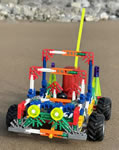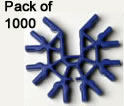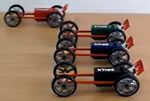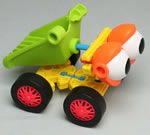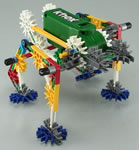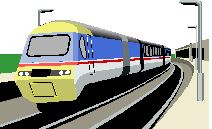
Railway challenge
Railway engines were first powered by steam engines, and then later by diesel engines and electric motors. Can you make an electric-powered railway engine, that will run on a railway track?
Levels of difficulty:
Level 1 - Make a railway engine that will run on a straight section of track
Level 2 - As level 1, and it will also go around curves
Level 3 - As level 2, and it will pull a train of two trucks
Equipment: K’NEX set, plus a K'NEX battery motor, and (ideally) an oval-shaped ‘G’ gauge railway track
Approach: What shape will your railway engine be? How will you attach the wheels? Will they be the right distance apart to fit on the track? How will the motor turn the wheels?For level 2, test your first model. If it becomes de-railed when it reaches a curve, think how you can improve it. Might it work better going the other way? Will you have to make one set of wheels swivel, to follow the curve around? For level 3, how can you make two trucks that will be easy to pull around? If the driving wheels of your railway engine slip when it tries to pull the train, how might you prevent this?
Handy Hints (please click to view):
A2 - 3 ways to connect K'NEX rods and connectors
W5 - Wheels and tyres
W6 - Making rods turn with wheels or connectors
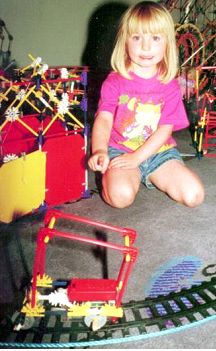
Teachers' Notes
The aim of the project is to build a powered vehicle to run on a railway track, which will probably need significant testing and improving before it meets the level 3 objective.
Possible solution: See photo.
Before starting: If possible, look at a picture of a railway engine with wheels that swivel as it goes rounds curves.
Conclusion: Firstly, ask the children to explain why a simple fixed-wheel railway engine becomes derailed at a curve (because the force from the engine is pushing in a straight line). Then ask why having one set of swivelling wheels helps (because the force of the swivelling wheel hitting the edge of the track turns it). Finally, ask why adding too many trucks to a train stops it moving (because the friction between the track and driving wheel on the engine is insufficient to overcome the inertia of the train).
Copyright © Andy Shercliff 1996 and K'NEX User Group 2004

